John
Good And... Sons (GCB) Ltd – the story of a building
[British
Oil & ... Cake Mills]
Once a well-recognised feature of the Wet Dock in
Ipswich, this wharf has lost its famous lettering and became a hotel in
2003. Dating back to the 1800s, the redbrick
building in
which the hotel is set was once a merchant's warehouse and many
original features such as the arched windows, and iron columns and
beams have been retained.
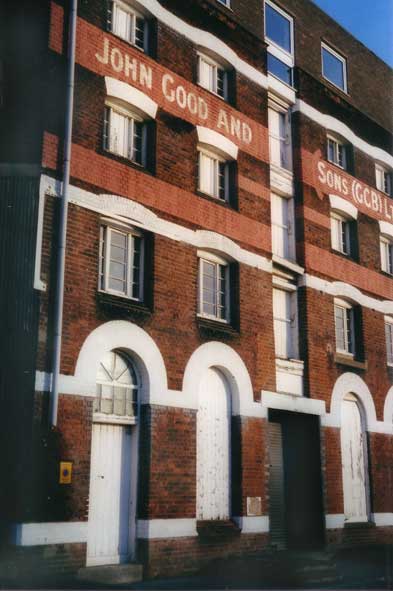 2000 images
2000 images
The unbridled use of reddish-brown paint suggests that
this lettering replaces
older signs, particularly the bracket shaped areas around the word
'Sons
(GCB) Ltd'. See below under 'Early 20th century' for the solution, whn
George Mason was the proprietor.
John Good & Sons Limited
In the year 1813 a young boy of 11 left his Scarborough home and
'signed
on' the sailing brig "British Volunteer" to begin a life-time's
association with the sea and shipping. Over the next 20 years John Good
continued his seagoing experience on vessels trading to the Baltic,
White
Sea and Mediterranean, gaining his Master's Certificate.
In 1833 he set up an office in Hull to found the company John Good
&
Co., as Ship Chandlers, Agents and Brokers, utilising the connections
he
had built up mainly with the Baltic and Finnish ship owners. After his
retirement
in 1864 his two sons continued to run the company, which had also
expanded
into ship owning. The Company's first regular liner agency was obtained
in 1883 for Finland Steamship Company's new cargo and passenger
services
between Finland and Hull. This agency continued for over 100 years.
The company has continued to expand, concentrating on general agencies,
ship agencies, and liner agencies, opening offices throughout the
United
Kingdom including Felixstowe and the Immingham ports. Today John Good
Shipping
provides a total transportation service and is one of the largest
independent
ship agency companies in the United Kingdom, still family owned and
run.
[current Chair: John Good according to their website
www.johngood.co.uk]
The part of the name which puzzled us was ''(G.C.B.)' and this refers
to General Cargo Brokers which in 1974 became a wholly owned subsidiary of John Good & Sons.
Presumably the two companies were close enough in 1965, when they set
up offices in Ipswich, for the parentheses to be added to the sign.
It was several years later, on re-examining the
photographic prints of this frontage, that we made out the light
coloured capital letters bleeding through the russet-painted strip
below:
'BRITISH OIL &... CAKE
MILLS'
either side of the central
teagle doors. It's still readable today, becoming visible
with time and weather. See the enhanced portion of the image below:
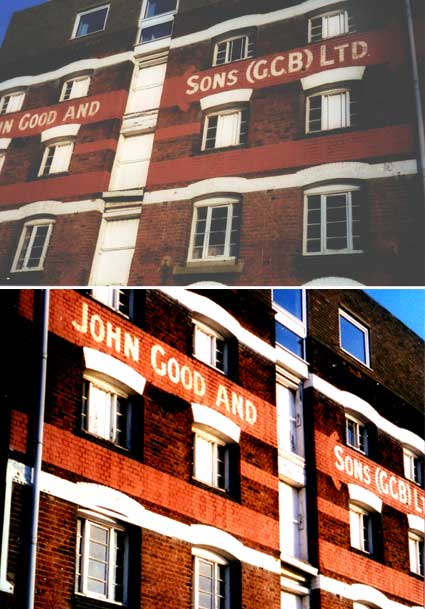
British Oil and Cake Mills,
also known as BOCM, of 29 Great St Helens, London
1899 The company was founded, taking over several companies and firms
of oil and cake manufacturers and oil refiners.
1914 Crushers, refiners and manufacturers of linseed, cottonseed,
rapeseed and other oils; manufacturers of linseed, cottonseed and feed
cakes.
1916 John Robinson and Co. of Bristol was acquired by BOCM.
1925 Lever Brothers bought British Oil and Cake Mills, one of its major
competitors and the manufacturer of New Pin Soap.
 Image from The Ipswich Society Image
Archive
Image from The Ipswich Society Image
Archive
The above photograph from The Ipswich Society Image
Archive (see Links) of the
north elevation of the Isaac Lord merchant's
house in Fore Street shows, at the left, the large iron gates leading
the the comapny's yard and building which bear the sign 'JOHN GOOD
SHIPPING'.
Pauls Agriculture was founded in
Ipswich in the early 19th century, initially to trade in malt and
barley for the brewing industry. This expanded into trading of maize
and other foods for horses. From the early 1900s, they started to
produce food for other animals too.
In 1992 Unilever sold BOCM Silcock to merge with Pauls Agriculture to
form BOCM PAULS LTD (currently owned by ForFarmers Ltd, based in the
Netherlands).
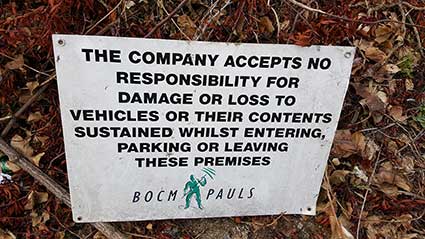 2016 image
2016 image
[UPDATE 21.9.2016: This
enamelled metal sign was found in a pile of cuttings and rubbish in the
car park close to the Jewish Cemetery.
Ripped from the wall, it was probably installed in the last ten to
twenty years, and is a small trace of a major occupant of the Wet Dock
in Ipswich.]
Early 20th century
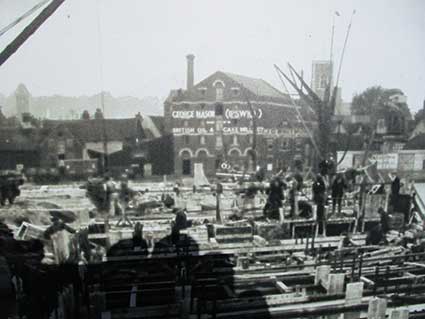
[UPDATE 27.2.2021: this
detail was photographed from the Window museum display
on the Wet Dock run by the Ipswich Maritime Trust (see Links). We hazard that this view of the the John
Good building across the barge-filled dock from the island site is
early 20th century. At that time the mill was run by:
'GEORGE MASON (IPSWICH)
BRITISH OIL & CAKE MILLS LTD.'
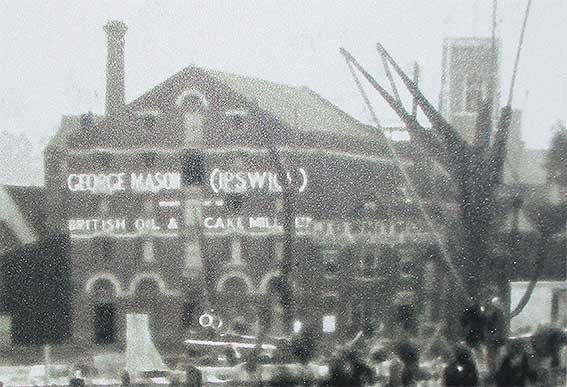
It certainly appears that this photograph has been retouched to
emphasise the lettering; it does, however, answer the question of the
large bracket shapes (either side of the 'SONS (GCB) LTD.' part) which
were obliterated with brick-coloured paint to make way for the John
Good sign shown in the photographs at the top of this web-page. The
'J.D. WHITMORE' sign can be seen to the right, between two masts.
Period photographs (1950s/1960s?)
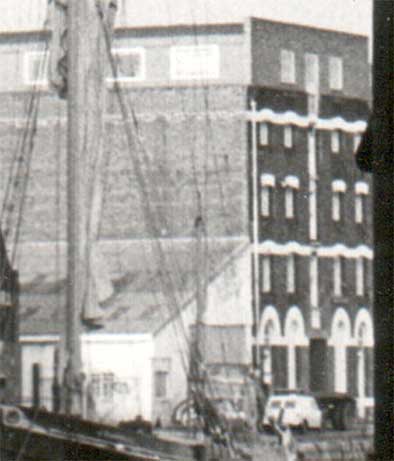 Close-up of 1960s photo on The changing dock page
Close-up of 1960s photo on The changing dock page
The above view of the John Good warehouse may date from the
1960s (that's a mini van parked in front, isn't it?). It shows
that the
frontage doesn't bear any readable lettering at that time.
The changing dock page also shows a
post-1939 long
view of part of Common Quay, Wherry Quay and part of Neptune Quay.
1964
Lying between 'Isaac Lord' and 'J.D. Whitmore' ship
chandler and sail-maker (and
with the tower of St Clement's Church behind it) this 1964 detail of
Neptune Quay from the island shows the original sign, a year before
John Good took over the building. The only part missing from our
deductions above is the very definite article at the beginning and the
'Limited':
'THE BRITISH OIL & CAKE
MILLS LIMITED'
The building is markedly different at this time: the
upper portion is pointed, bearing a pitched roof, the lower portion
carries a canopy along its whole width including the low adjoining
building with a sloping roof to the left. The main roof line was
clearly changed and a box-like
extension built which survived until the warehouse became an hotel in
2003 and the grey extension was built (shown below).
The lower lettering strip running above the arched windows and
doors wouldn't be added until the removal of the canopy, hence the
difference between this sign on the upper strip (later occupied by the
John Good lettering) and the ghost sign on the lower strip.
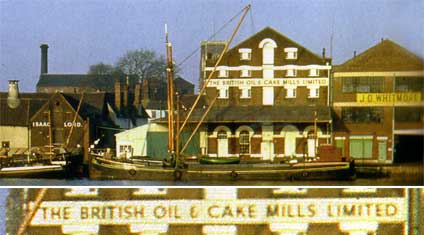 1964 image
1964 image
2003
Sadly, all of this lettering has now been expunged with
a red-brown paint (but,
as
mentioned above, it's gradually reappearing), as part of the conversion
of
the wharf to an hotel. However, 'SALTHOUSE ... HOTEL' painted
on an added brick-coloured strip on the upper part of the
building facing the Wet Dock
on the front and:
'SALTHOUSE
HARBOUR
HOTEL'
on the side wall was, at least, of the same character
as the
John
Good lettering. Clearly an hotel, opened in July 2003, which can't
quite make up its mind
what it's called. The rather ugly, grey, upper portion has been added,
but
on the positive side its resores the pitched roof and the building is
once again in use as part of the
waterfront
regeneration. The building of a modern extension on the Whitmore
building site (later Neptune Snooker Club) virtually doubled the size
of
the hotel.
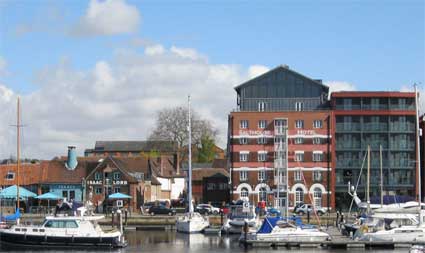 A similar view in 2013
A similar view in 2013
A similar view from Tovell's Wharf (see the Wet Dock map) on the 'Island'
formed by New
Cut and the Wet Dock. The kiln vent above the Isaac
Lord maltings is
still in place, as is the company name lettering. Behind is the roof of
the Ransomes lawn mower works later converted to accommodation called
The Foyer in Star Lane, minus its tall chimney.
J.D. Whitmore's building has been replaced by the glass-fronted
Salthouse Harbour Hotel extension. The canopy on the BOCM building at
ground level has gone, as has the extension to the left with its
sloping roof.
2000
The photographs below are from The Ipswich Society's Image
Archive (see Links) show the John Good and
Whitmore buildings still standing in the late 1990s/2000.
 c.2000 image
c.2000 image
The lean-to building in brick and corrugated iron in the
foreground still stands, creating a narrow access to the yard behind.
'JOHN GOOD SHIIPING' can be read on the sign. The edge of the Isaac
Lord maltings is on the left; the Bellway apartments called Neptune
Square are at the far right. Note the blank side wall of the main
building.
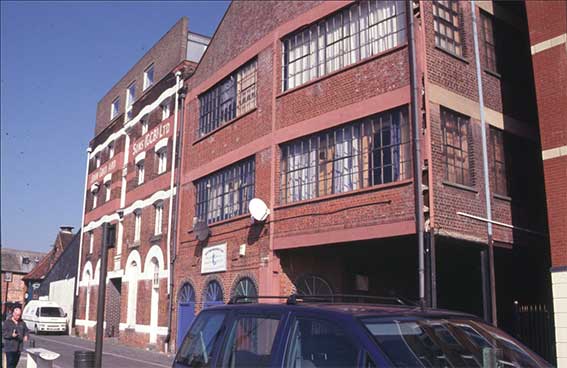 c.2000 image
c.2000 image
J.D. Whitmore ship chandler and sail-maker once
occupied this building, which features a deep recess, presumably for
unloading carts and lorries, in the foreground which is supported by
vertical steel girders. At the time of this photograph, the building
features a sign reading 'NEPTUNE SNOOKER CLUB'. The building line
changes halfway across the frontage in the form of a slight angle to
the right of the satellite dish. This can also be observed on the
facade of the Salthouse Hotel which replaced it.
2003
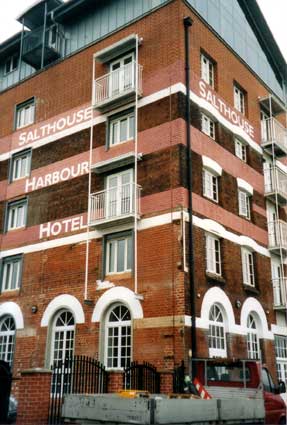 2003 image
2003 image
2013
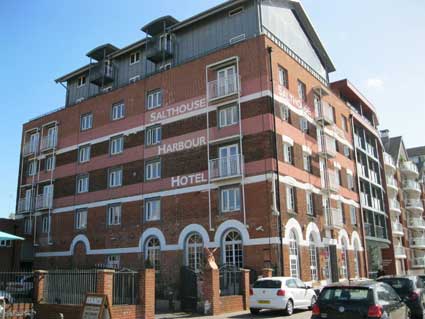 2013
images
2013
images
Note that the blank side wall of the building
has been pierced by windows in the arched style of the facade (one of
them blank) and a doorway. the strips of red-brown paint have been
continued from the front to accommodate the hotel name lettering.
Below: another view of the lettered side wall
of the hotel; and the side of the car park opposite (the walls of the Isaac Lord complex, the only one which runs
from the quayside down to Fore Street).
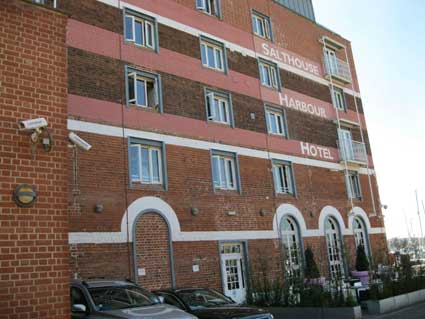
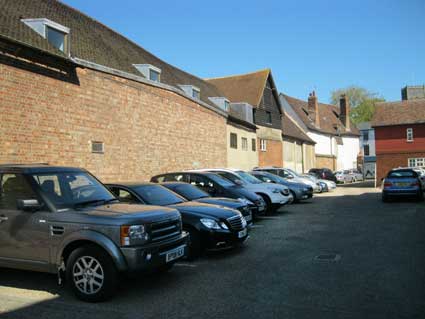
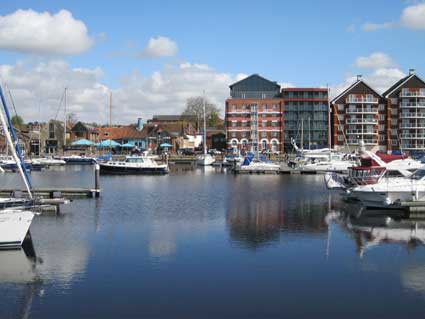

Above: the view across the pool of the Wet Dock. The central
loading doors of the old warehouse have been converted into glazed
doors with balconettes, with a central door on the ground floor.
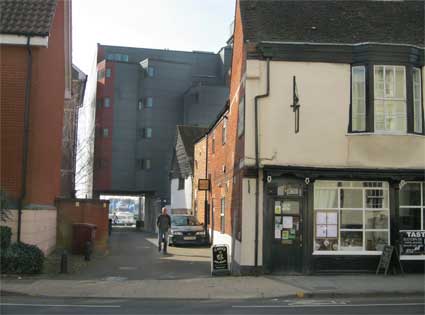 2014
image
2014
image
The view of the Salthouse Harbour Hotel
extension from the lane beside the Neptune Café (to the right). The
characterless grey block bridges the lane so that the Wet Dock can be
seen through the tunnel. The early buildings in the midground and
foreground are dwarfed. Sadly, a story repeated elsewhere around the
Wet Dock where requirements for increased accommodation (and profits)
on
a relatively small land footprint result in higher and higher
structures hiding the docklands from view in the surrounding streets.
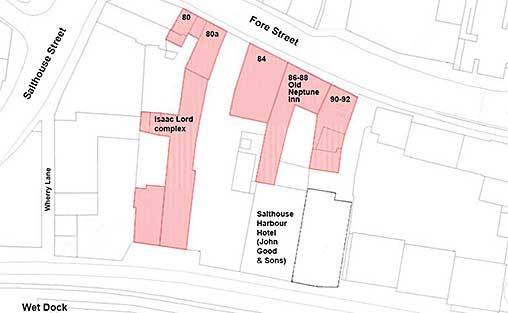
The map of the modern north-west part of the Wet
Dock quays shows the relative size and relationships of the Isaac Lord,
Old Neptune Inn and John Good mill/Salthouse Harbour Hotel features.
Why
'Neptune Quay'?
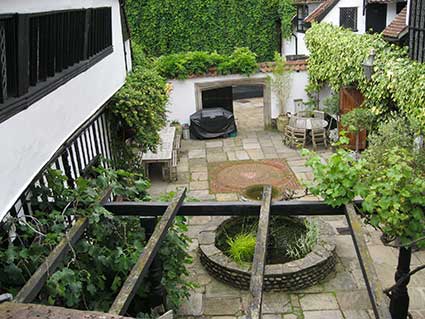 2016 image
2016 image
This apparently obvious
question (Wherry Quay was named after the Wherry Inn – in 2016 the site
of the Isaac's extension, Griffin Wharf was named after the Griffin Inn
on the corner of New Cut West and Bath Street – see our Bourne Park page) is begged by the
distance of the Neptune Inn frontage from
the dock. The above view of the Old Neptune courtyard shows the
restored buildings with a view of the Wet Dock obliterated by the back
wall of the John Good Building (now the Salthouse Harbour Hotel),
covered in Virginia creeper. In fact the John Good mill is a newcomer
to this ancient building; the Old Neptune had its own quay leading off
the natural harbour, long pre-dating the building of the Wet Dock in
1842. The quay, presumably with a removable bridge to allow traffic
along the quayside when the Neptune Quay inlet was not in use, would
have enabled lighters to unload goods directly avoiding unnecessary
handling and carting.
Related pages:
The Question Mark
Christie's
warehouse
Bridge
Street
Burton Son & Sanders / Paul's
College Street
Coprolite
Street
Cranfield's
Flour Mill
Custom House
Trinity
House buoy
Edward
Fison Ltd
Ground-level dockside furniture
on: 'The
island', the northern quays
and Ransome's
Orwell Works
Ipswich
Whaling Station?
Isaac Lord
Neptune Inn
clock, garden
and interior
Isaac
Lord 2
The Island
Merchant
seamen's memorial
The Mill
Nova Scotia
House
New Cut East
Quay
nameplates
R&W Paul malting
company
Ransomes
Steam
Packet Hotel
Stoke
Bridge(s)
Waterfront
Regeneration Scheme
Wolsey's
Gate
A chance to
compare
Wet Dock 1970s with 2004
Wet Dock maps
Davy's
illustration of the laying of the Wet Dock lock foundation stone,
1839
Outside
the Wet Dock
Maritime Ipswich
'82 festival
Home
Please email any comments
and contributions by clicking here.
Search Ipswich
Historic Lettering
©2004 Copyright
throughout the Ipswich
Historic Lettering site: Borin Van Loon
No reproduction of text or images without express written permission
 2000 images
2000 images
 Image from The Ipswich Society Image
Archive
Image from The Ipswich Society Image
Archive 2016 image
2016 image

 Close-up of 1960s photo on The changing dock page
Close-up of 1960s photo on The changing dock page 1964 image
1964 image A similar view in 2013
A similar view in 2013 c.2000 image
c.2000 image c.2000 image
c.2000 image 2003 image
2003 image 2013
images
2013
images



 2014
image
2014
image
 2016 image
2016 image